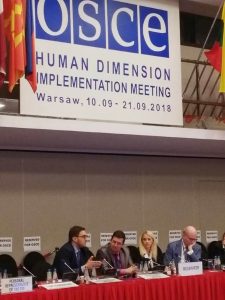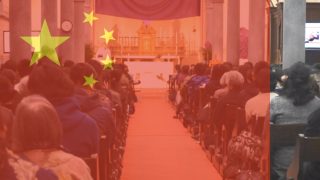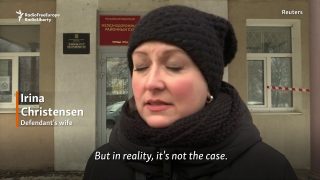How China and other totalitarian regimes persecute religious minorities by claiming they are not “real” religions. The paper by Massimo Introvigne at the side event “Myth/Reality? Freedom of Belief, No Discrimination and Tolerance in the OSCE Area,” at the OSCE (Organization for Security and Cooperation in Europe) Human Dimension Implementation Meeting, Warsaw, September 13, 2018
by Massimo Introvigne
Religious freedom, myth or reality? If we would ask each participating State in the OSCE, and indeed any State in the world, whether there is religious freedom in their country, all would answer “yes.” Even the Chinese Constitution proclaims religious freedom.
The next question would be, “But why are some religious minorities banned and persecuted in your country?”. They would answer that “they are not at all religious minorities, but something else. They are not religions but criminal, or extremist, or subversive organizations that have nothing to do with religion.”
Article 300 of the Chinese Criminal Code makes it a crime to be active in a xie jiao and Chinese authorities publish periodically lists of xie jiao, which include Falun Gong, The Church of Almighty God, and many other religious groups.
It is important to emphasize that for the CCP and the Chinese courts xie jiao are not religions, but subversive or criminal groups. Any Western objection about religious liberty is dismissed as irrelevant. Chinese authorities would answer that religious liberty is guaranteed by the Chinese Constitution, but xie jiao have nothing to do with religion.
This is an old attitude, and not only a Chinese one. Usually those hostile to “cults,” when confronted with the objection that the repression of “cults” violate religious liberty, answer that “cults” are not religions. This was the position of the anti-cult camp in the “cult wars” of the late 20th century.
But the position dates back to at least one century before the “cult wars.” It was difficult to deny that in 19th-century America Catholics were discriminated and persecuted. On the other hand, America’s patriotic narrative portrayed the United States as a country whose very origins very rooted in the affirmation of religious liberty. Anti-Catholic crusaders such as Charles P. Chiniquy (1809–1899), a former Canadian Catholic priest turned Presbyterian minister, insisted that Catholicism was not a religion but a subversive political organization, a business empire, or a criminal racket promoting immorality. It was only by asserting that Catholicism was not “really” a religion that the image of the United States as the country of religious freedom could be reconciled with the American reality of anti-Catholic discrimination.
Perhaps, this attitude was even older. Historians tell us that the persecution of Christians in the Roman Empire was justified by claiming that Christianity was an immoral subversive organization rather than a religion.
Russia has introduced the category of “extremism” to ban groups such as the Jehovah’s Witnesses and harass others such as Scientology. Again, Russia claims that “extremist” groups are not religions. However, the criteria used by Russian courts to distinguish “extremist” movements from “genuine” religions are somewhat nebulous. They include “exclusivism” (i.e. claiming that the group’s religion or spirituality is the only “true” or valid one), “breaking the families” (when only one spouse joins or leave the “extremist” group, divorce is frequent), mistreating ex-members, and showing an inordinate interest in money. Obviously, this criticism can apply to mainline religions too. The Russian Orthodox Church itself claims that most other religions are false and heretic. Divorce because one spouse converted to a different religion is frequent in all religions. The Catholic Church branded “apostate” ex-members as “vitandi,” in Latin “persons to be avoided,” until the Second Vatican Council, and in Italy we even had a law that ex-priests cannot become teachers in any school or college. An inordinate interest for money is something secular humanists find in all religions, and critics find it in the Russian Orthodox Church too.
To claim that a group is not a “real” religion was merely a rhetoric device in the Roman Empire and 19th century America, as it is in contemporary anti-cultism for “cults,” in Russia for “extremist movements,” and in China for xie jiao. Who decides that one religion is “genuine” and another only “pretends” to be a religion? Often, as sociologist Larry Greil claimed in 1996, “religion” is “not (…) a characteristic which inheres in certain phenomena, but (…) a cultural resource over which competing interest groups may vie.” And the competition, in different ways in democratic and in totalitarian societies, is settled not by science but by power. In 21st century China and Russia, the motto of the imperial Roman jurist of the 2nd-3rd century AD, Ulpianus (170–223), still resonates: “Quod principi placuit, legis habet vigorem,” “What pleases the emperor becomes enforceable law.” In Russia, the government decides which groups are “extremist.” Throughout the OSCE area and beyond, anti-cultists exclude from the sphere of religion groups they do not like, including Scientology, yet they are very vague when asked to define their notion of religion. In China the CCP, the new emperor, decides what groups are xie jiao. They are taken out of the sphere of religious liberty and human rights. Their members are in fact de-humanized. They should be, in fact, in CCP’s own slogan, “totally eradicated like tumors.” Tumors have no rights, and can only be eradicated through violence.




